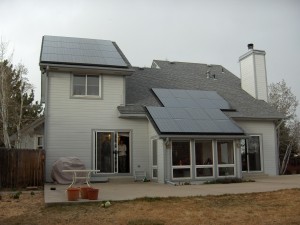I flipped the switch on the solar array today and watched my electric meter begin to run backwards, erasing not just today’s electricity usage, but most of yesterday’s as well. Today was a very sunny day in Colorado. These words were written on a computer that was, at the time of the writing, operating on solar energy alone.
For as long as I can recall, I’ve always wanted to own a house that ran on solar energy. My dad worked on the very first government communications satellites back in the 60’s and 70’s and he’d sometimes bring home bits and pieces of that project for my amusement. One of those early artifacts was a solar cell which is one of the technologies that allowed satellites to be practical in the first place. I remember being fascinated as I watched the solar cell power a small motor from a lamp. This was long before solar cells started showing up in calculators (which didn’t even exist at the time). The solar cells I played with back then are very similar to the ones that are now powering our entire house.

A 5.6 kW Solar Array Generates all our electricity
This solar installation uses a method called ‘net metering’, which feeds any excess electricity to the grid for use by my neighbors when the sun is shining. During this time, my meter runs backwards. After the sun goes down, my meter runs forward again. Based on the size of the array and our annual electricity usage, our house should have net zero electricity consumption over the course of the year. A net metering system has a few advantages over batteries because I don’t have to worry if we get several days with no sun, since I’m still hooked up to the grid. Also, a bank of batteries to hold just a day’s worth of electricity would be enormous, weighing over 2000 lbs. and they would also be costly. The savings from generating your own electricity are real, since for every kWh I generate, it means less coal or natural gas that needs to be burned back at the power plant.
I’ve always looked at the large south facing roof of our house as a perfect location for a solar array and now it’s here.
For those interested in specifics, the system includes 32 Sharp 176W panels connecting in 2 strings feeding a Sunny Boy inverter. Total capacity is 5.6 kW.


Ah haha, you can Terri and I in the shadows!
Chris
I’ve been very interested in this as well…
What did it run you to purchase and install this system? Any idea how long it will take you to pay for it with net electric bill savings?
The cost to install was about $7.15/watt, less a $4.50 per watt rebate from the power company. That came out to about $14.5K. That amount is tax deductible, so depending on one’s tax rate, the install cost is down around $2/watt. Thus its payback is around 10 years, or less depending on what happens to electric rates. The panels are guaranteed for 20 years. It’s one of the only income producing assets I can think of for the home. Most things you add to a home tend to require more money to maintain them.
Nice. My sister had her house in CO done too! I took a short class at a community college in zero energy technologies. It was a bit harder then I thought it would be. Lots of crawling around the attic.
My production numbers with a 10.1KW system will not be that good compared to CO (9100kwhr/year) because of the rain and clouds, however, I’ll be making enough energy to power my house plus three more. I use little energy (less then 3000kwhr/yr).
Hi Roy, That’s amazing that your array will have 4x the capacity of your own consumption. Are you thinking of getting an electric car or something to absorb your over production? Our electric power consumption is on par with the U.S. national average (~720 kWh/month) and so we come pretty close to matching our array, with a slight over capacity. We have an electric oven and range as well as an electric clothes dryer, and those are responsible for 30%-40% of our consumption. The power company pays us for any over production each year, but at a wholesale rate which comes out to about 3 cents per kWh. In Europe, the feed-in tariffs are on the order of $.50/kWh which is enough to make generating solar power a profitable venture.
I decided to do some web searching and noticed that Washington state passed a feed-in tariff bill (HB1086) and it would appear that you’re getting $.65/kWh. Can that be right?